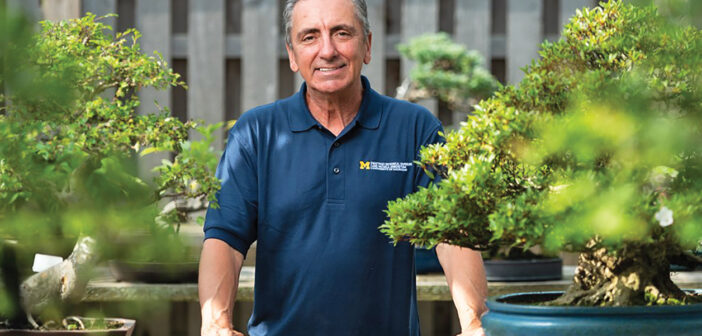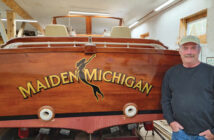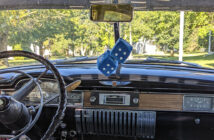At times, Anthony Kolenic, Director of the University of Michigan’s Matthaei Botanical Gardens and Nichols Arboretum, is in awe as he watches Jack Sustic meticulously care for its extensive bonsai collection.
“When I see Jack working in the Bonsai Studio, there’s a steadiness that’s matched by joy, and it’s quite amazing,” he says. “All he does is aimed at the best outcome for the tree. Jack told me early on in his time here that bonsai artists are in deep conversation with each tree, pursuing a particular artistic intent for it while also responding to and following its natural capacities and rhythms.”
Originally from Linden and now living in Swartz Creek, Sustic has been dedicated to caring for bonsai collections for nearly 35 years. His position as Matthaei’s bonsai curator is only the latest chapter in the distinguished career of a passionate man considered one of the nation’s foremost bonsai experts.
Bonsai, Japanese for “tree in a pot,” refers to designing and maintaining miniature living trees or shrubs in a container.
“Jack embodies the finest qualities of the great bonsai master Saburo Kato, who founded the World Bonsai Friendship Federation to spread friendship and goodwill.”
Felix Laughlin, President
National Bonsai Federation
“My bonsai career has absolutely been such a fun ride and I’m so grateful for all of the unforgettable experiences and relationships it has brought me,” the 62-year-old Sustic says. “I’ve literally traveled the world to learn from some of the greatest-ever bonsai masters. The opportunity afforded me to work at the National Bonsai & Penjing Museum (in Washington, D.C.) was very special. It’s kind of amazing what my initial interest in bonsai led to.”
Sustic served twice as the National Museum’s curator (2002-05 and 2008-16) after making an impression while serving as assistant curator. His time in the nation’s capital followed a stint as caretaker of plants, including bonsai, at the Riverbanks Zoo and Botanical Garden in Columbia, SC.
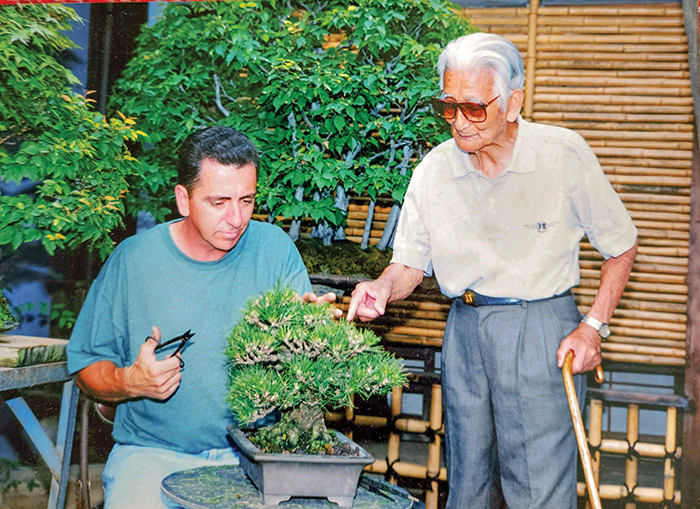
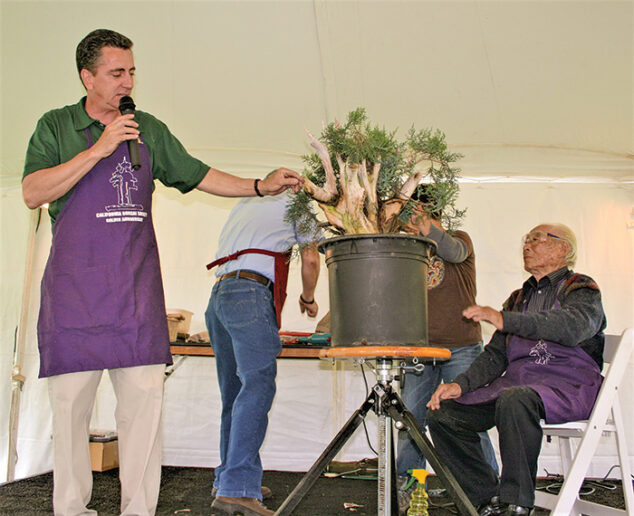
(L-R) Jack gained valuable knowledge from acclaimed Bonsai Masters Harry Hirao and Saburo Kato, among others.
He has also made an impact while serving in prominent positions for several bonsai organizations, including as North American Bonsai Federation president, National Bonsai Foundation co-president and World Bonsai Friendship Federation regional director.
Sustic’s trees have been exhibited in many national bonsai exhibitions. One of them was even selected as an international winner in the World Bonsai Friendship Federation photo contest in 2005.
Following his second term at the National Museum, Sustic returned to Michigan. He was enjoying semi-retirement and taking care of his own collection of roughly 75 bonsai when his current gig began with an out-of-the-blue phone call from Anthony Kolenic in early 2021. Matthaei Bonsai Specialist Carmen Leskoviansky was leaving for a three-year apprenticeship in Oregon and someone was needed to curate and maintain the collection until he returned.
“I had settled into the role of a gentleman bonsaist and was doing presentations and things like that when I got the call from Matthaei,” Sustic says. “I agreed to manage their collection while Carmen was away and it’s been a very satisfying, unexpected new phase of my career. Little did I know that the collection was going to expand with the masterpiece trees they were getting. Overall, we have a great group of trees that really put on a show when they bloom.”
The collection, which Sustic calls one of the most unique in the country, includes rare azalea bonsais. Each tree, some more than a century old, is presented on an individual stand. By the end of this year, thanks to a generous donation, the collection is expected to grow to over 170 trees, prompting the construction of additional platforms and displays by Sustic and his team of staff and volunteers.
Matthaei’s collection is No. 23 on the hookedonbonsai.com recent listing of America’s Top 25 Bonsai Gardens. The National Bonsai & Penjing Museum, Sustic’s former home, is No. 1.
Sustic’s summer duties include watering, pruning and checking trees for bugs and diseases. Fall is a time to assess how branches have grown, fix any that are growing at strange angles, and prepare trees for winter storage to protect their roots.
“Jack’s experience, talent and affable personality have had huge impacts on our organization,” Kolenic says. “He has helped grow the heft and depth of our collection. I have learned a great deal from him and, as we plan our next steps to care for our growing collection, his voice and insights have been invaluable.”
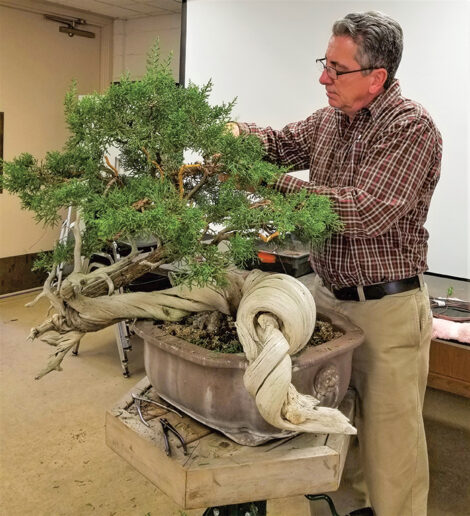
The Carman High School grad likes to say the seed for his bonsai passion was planted while he was stationed outside Seoul, South Korea with the U.S. Army from 1985-87. Wanting to explore the surrounding community, Sustic took frequent bus rides from base.
“One of the things I learned is that every tree comes with an imaginary book filled with its history and it’s important to honor that history.”
Jack Sustic
One of those excursions led him to a place known as the Green Zone.
“It was full of horticulture-related businesses and a couple of them specialized in bonsai,” Sustic recalls. “It just caught my eye and I started hanging around there. How the trees grew and were cared for just drew me in.”
Sustic vowed to learn the craft that had captured his imagination and the opportunity to do just that came while he was stationed at Fort McClellan near Anniston, AL after returning from South Korea. Sustic joined the Alabama Bonsai Society, training with experts at workshops and starting his own collection.
While the thought of bonsai as a career had not crossed his mind, Sustic’s time with the ABS prompted him to study horticulture and greenhouse management at Michigan State University, which led to his position at Riverbanks Zoo.
In 1996, he was granted permission to serve a six-month internship at The National Bonsai & Penjing Museum and returned to South Carolina. Sustic wasn’t there long when he was offered a two-year position with the museum.
Despite the position’s limited nature, the allure of practicing bonsai full-time was too strong for Sustic to resist and the gamble paid off.
“There was never a grand plan to make bonsai my career, it just kind of happened gradually,” he says. “My wife agreed I should take the leap and within six months, an assistant curator position became available and I was hired for it.”
Roughly five years later, Sustic became curator before leaving the post in 2005 when his father needed help with his farm and the Sustics moved back to Michigan. He was able to return to the position in 2008 when his father’s situation stabilized.
Bonsai can live for hundreds of years and one of the most notable Sustic cared for at the National Museum is a nearly 400-year-old specimen that survived the atomic bombing of Hiroshima. It was donated in 1976 by Japanese Bonsai Master, Masaru Yamaki.
Perhaps the world’s most famous bonsai, Goshin (“protector of the spirit”) created by the late Japanese American master John Naka, is also there. Goshin is a planting of 11 junipers representing Naka’s 11 grandchildren at the time it was created about 45 years ago.
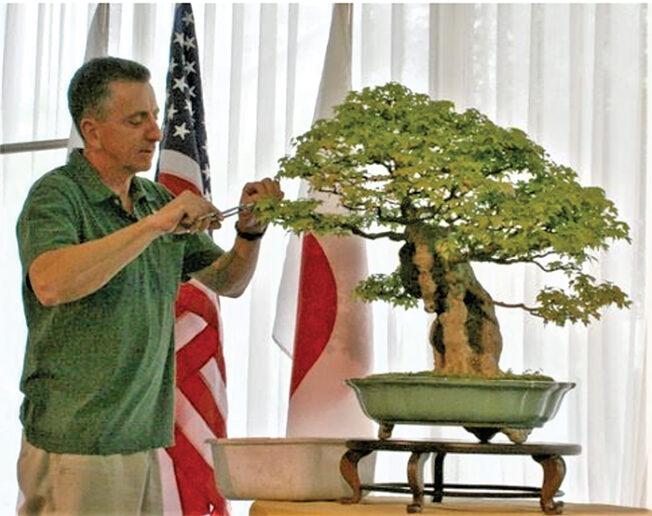
Naka is among the masters from whom Sustic attained valuable bonsai knowledge. He also learned from legendary Japanese Masters Harry Hirao and Saburo Kato.
“One of the things I learned is that every tree comes with an imaginary book filled with its history and it’s important to honor that history,” Sustic says. “John Naka is really the father of American bonsai and an incredible teacher to me. I’ll always cherish the time I spent at Saburo Kato’s nursery in Japan. Those guys are rock stars and time with them was priceless.”
Many different kinds of trees can be used for bonsai, but Sustic feels juniper, which can be purchased at area garden centers, is probably best for beginners.
“Junipers are the most forgiving, meaning it’s not a big deal if you forget to water them in the morning, but others you can’t forget,” says Sustic, who has been caring for one of his trees since 1990. “I recommend purchasing any trees for bonsai in person. Too often, I hear from people who say what they got online was not what they really wanted.”
He says it’s also important to remember that, for the most part, bonsai are outdoor plants. Tools of the trade include concave pruners and wire to position branches to their desired growing positions. Wire should be removed within the first year, depending on the species, before it scars the branches.
Trees should also be re-potted about every two years at which time a certain percentage of roots are cut off, prompting new root growth. Sustic also recommends taking classes and viewing videos to gain further knowledge.
“The biggest mistake people make is bringing a bonsai inside,” he says. “The majority of species must live most of their lives outside. Just learn what each species requires and spend the time with the trees. Eventually, you’ll develop something very beautiful.”

